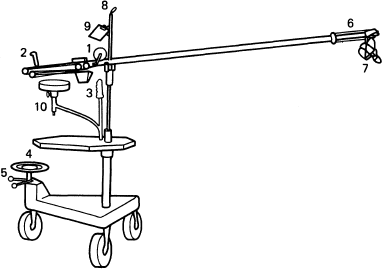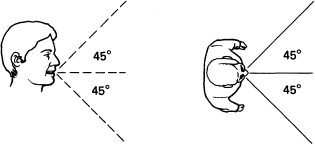Sound Pick-up
There are various ways of supporting microphones in a television studio. Some of the very important are set out below.
Boom
This is easily the most versatile method. With it, an experienced operator can position a microphone with great accuracy at any angle and at any position in a large area. However, booms are expensive and it can take months or even years for a boom operator really to learn the art. Furthermore a large space is needed for the benefits of a boom to be gained, so this often precludes their use in small studios.
Fishpole
This is a rudimentary but nevertheless useful form of boom. It consists of a length of light rod (stout bamboo is satisfactory) with the microphone fixed to one end. The rod is normally 2–3 metres long. An advantage of the fishpole is that, unlike the boom, it can be used below the level of a presenter’s head and still be out of shot. Operator fatigue can be a problem with long takes.
Stand microphones
Stands tend to be unacceptably obtrusive in shot, except perhaps for some musical programmes. However, they should form part of every studio's equipment for out-of-vision applications.
Personal microphones
These can be quite unobtrusive and can give great freedom of movement to a presenter. It is often possible to conceal such a microphone completely beneath clothing, but problems can occur from static and clothing rustles (see page 112).
Slung microphones
It is sometimes possible to get very satisfactory sound coverage from microphones hanging over the set. Be careful to avoid perspective problems—from, for example, a presenter beneath a slung microphone walking towards camera but getting further from the microphone.
Microphone positioning
A few general points, applicable to both fishpoles and booms are:
1. As a rough guide a microphone at arm’s length and at 45° to the speaker’s mouth should give reasonable results. Depending on the acoustic environment, greater working distances are possible with gun microphones.
2. The position of lights should be noted to avoid shadows of the microphone appearing in the picture.
3. The sound operator must note all camera positions, zoom angles etc. to ensure that the microphone never appears in shot.
The boom arm’s length (3–6 metres) is adjusted by a wheel (1 ), and pivoted in its central cradle. The microphone can be titled and rotated by a control lever (2). The overall height of the boom arm and platform can be adjusted (3) between 1 and 1.5 m. The boom pram is steerable (4) and can be held stationary by a brake (5). (6) Extending section. (7) Microphone in cradle. (8) Talk-back microphone. (9) Script board. (10) Seat.

Fishpole

Acceptable sound pick-up angles

